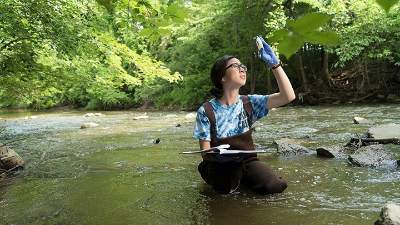About Us
Academics / Departments & Programs / Physics & Astronomy / About Us
Quick Facts
Research opportunities
As a physics and astronomy student, you will have incredible opportunities to work alongside professors both in and outside of the classroom.
- During the school year and in the summer, assist professors with research in theoretical and experimental atomic physics, biophysics, neurophysiology and more.
- Publish research findings with professors and other students in scholarly journals.
- Use the Calvin observatory (both on-site and remotely in New Mexico) to observe asteroids, stars and galaxies.
- Collaborate on research with your fellow students and professors in small, upper-level courses.
Facilities
Calvin students have access to state-of-the-art facilities and technology for use in courses, labs and research projects.
Research laboratories and computersSeveral research laboratories and hundreds of computers, funded by external grants and the university.
Examples include:
- atom trapping system, "optical molasses" using special magnets and lasers in high vacuum--Professor M. Walhout
- electronic cellular microprobe system to study electical signals in cell membranes--Professor L. Haarsma
- sophisticated computer models of atoms in extremely intense laser fields written by Professor S. Haan
- custom built equipment to study lipids and macromolecules--Professor P. Harper
- optically detected magnetic resonance in diamond nitrogen-vacancy point defects--Professor R. Balili
Two fully-equipped observatories, one on Calvin's campus and a robotically-operated telescope in Rehoboth, New Mexico.
These enable
- studies of asteroid dynamics--Professor L. Molnar
- studies of variable stars--Professor L. Molnar
- studies of globular star clusters--Professor J. Smolinski
Specially-equipped student labs, including equipment developed commercially for teaching in advanced laboratory programs by Professor D. Van Baak.
Examples include:
- quantum interference with single photons
- quantum entanglement of photon pairs
- measuring nuclear decay and cosmic rays
Take the next step:

ACADEMIC OPTIONS
With over 100 majors and programs, you’re bound to find something you love.
Browse by category
- Arts
- Business
- Communication & Media Studies
- Education
Undergraduate education
- Early Childhood
- Elementary Grade Bands
- Art: Pre-K to 12th Grade
- French: Pre-K to 12th Grade
- Health & PE: Pre-K to 12th Grade
- Spanish: Pre-K to 12th Grade
- Special Education
- TESOL: Pre-K to 12th Grade
- Secondary Education
- English: 5th to 9th Grade
- Math: 5th to 9th Grade
- Science: 5th to 9th Grade
- Social Studies: 5th to 9th Grade
- English: 7th to 12th Grade
- Math: 7th to 12th Grade
- Science: 7th to 12th Grade
- Social Studies: 7th to 12th Grade
- Health Sciences
- Exercise Science
- Kinesiology (Pre-professional Emphasis)
- Nursing
- One Health
- Pre-Dentistry
- Pre-Medicine
- Pre-Occupational Therapy
- Pre-Optometry
- Pre-Pharmacy
- Pre-Physical Therapy
- Pre-Physician Assistant
- Pre-Podiatry
- Pre-Veterinary
- Public Health
- Recreation Leadership
- Speech Pathology and Audiology (BA, MA)
- Master of Speech Pathology
- Theraputic Recreation
- Humanities
- Ministry
- Science, Technology, Engineering & Mathematics
- Social Sciences
- World Languages & Cultural Studies

Apply to Calvin
It all starts here! We accept applications on a rolling basis throughout the year. All completed applications receive equal consideration.
Start your journey
Visit Calvin
Find the visit option that works best for you and get a taste for life at Calvin!
Browse Visit Options Launch the virtual tour
Request Info
Learn why Calvin’s dedication to faith and discovery have earned it the rank of #3 among regional Midwest universities.

Costs & Financial Aid
Families from all economic backgrounds—many just like yours—are making Calvin work. Scholarships, grants and loans are the tools that make Calvin possible.
Explore financial aid & Scholarships How much does Calvin cost?